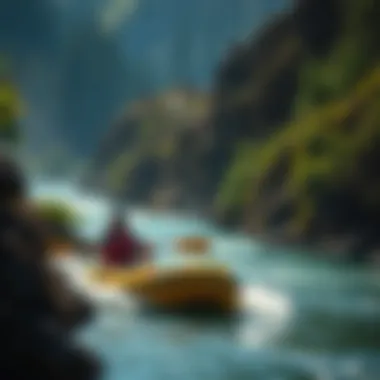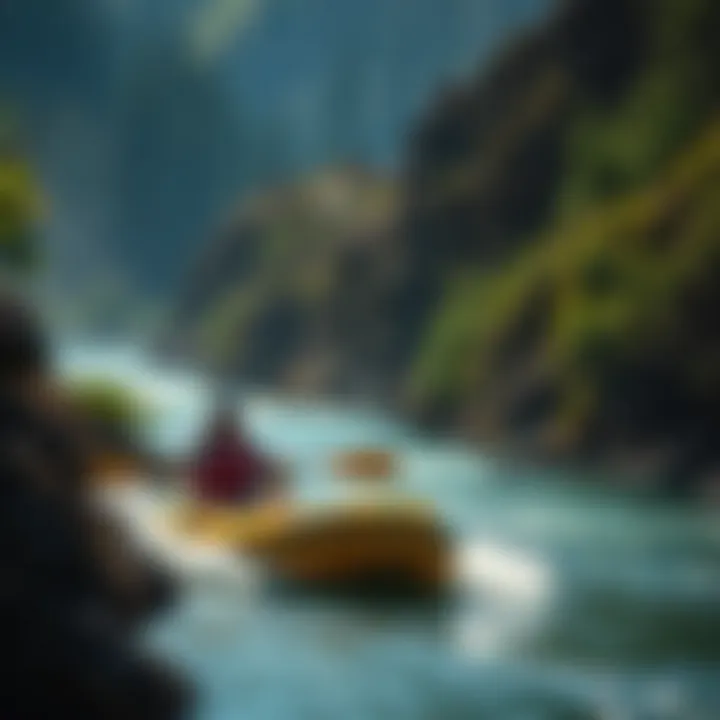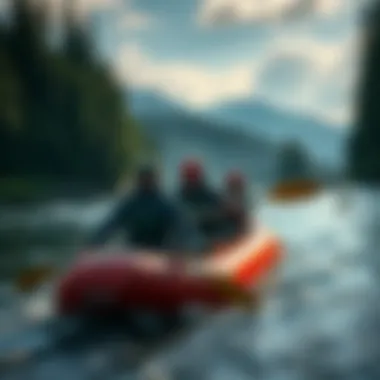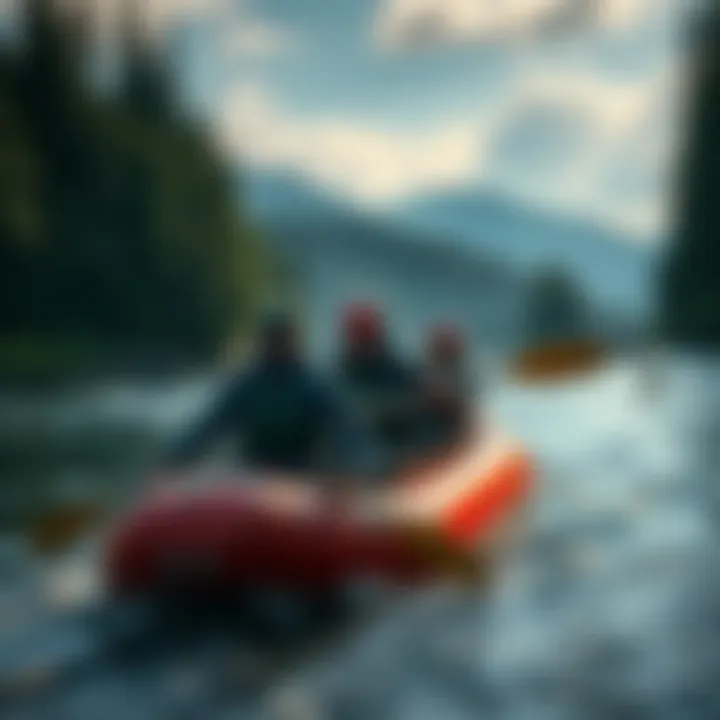Skykomish Rafting: A Comprehensive Experience Guide


Intro
Rafting on the Skykomish River presents not just a thrilling pastime but also a unique opportunity to connect with the natural world. Nestled in the Cascade Range of Washington State, this river boasts a distinct character that calls out to adventurers and nature lovers alike. As we plunge into the details, it’s essential to grasp the multifaceted experiences one can encounter on this river, which serves as a natural artery for recreation and environmental appreciation.
Understanding the geography and ecosystem surrounding the Skykomish enhances the rafting experience significantly. The river flows through stunning landscapes characterized by sweeping forests, expansive mountain views, and rich wildlife. Rafting here isn’t merely about navigating rapids; it’s about immersing oneself in an intricate environment shaped by centuries of natural and human history. This article will explore the various aspects of rafting on this remarkable river, including geographical significance, different types of rafting experiences, necessary safety protocols, and sustainable practices essential for preserving this precious resource.
As we journey through, readers can expect a wealth of information, whether you're a rafting veteran or a newcomer eager to dip your toes into the adventure. By delving deeper into the experiences and responsibilities associated with Skykomish rafting, we aim to foster a greater appreciation for not just the sport, but the environment that sustains it.
Engaging with this incredible natural asset encourages a broader discussion about stewardship and sustainable practices, ensuring that future generations can also revel in the beauty and excitement of the Skykomish River. Let's embark on this exploration and unearth the essence of rafting in this beloved region.
Intro to Skykomish River
The Skykomish River is not just another body of water; it’s a flowing ribbon of natural beauty synonymous with both adventure and serenity. Nestled in Washington State's Cascade Range, this river has become a sought-after locale for rafting enthusiasts and nature lovers alike. Understanding its significance is crucial as it lays the groundwork for a deeper appreciation of the rafting experience to come.
Geography and Hydrology
The Skykomish's geography is as diverse as the experiences it offers. Originating from the sponge-like valleys of the Cascades, it winds its way through lush forests and rocky gorges, creating dramatic landscapes that change with the seasons. It covers an expanse of approximately 45 miles, flowing from its pristine headwaters near the Snoqualmie Pass down to its confluence with the Snohomish River.
The river’s hydrology is equally intriguing. With snowmelt being the primary contributor to its flow, the seasons significantly dictate the river’s characteristics. In spring, the increased meltwater transforms the Skykomish into a raging torrent, offering thrilling rapids for the daring. Summer mellowing brings about calmer waters, ideal for families and those seeking a less intense experience. The unique combination of glacial, rainwater, and mountain runoff leads to varied water conditions, particularly fascinating for those interested in ecology or environmental studies.
"Water is the driving force of all nature." – Leonardo da Vinci
This seemingly straightforward physical aspect reveals the river's role in the regional ecosystem. It acts as a habitat for numerous species, both aquatic and terrestrial, highlighting the importance of responsible engagement with this fragile system. Recognizing the geography and hydrology of the Skykomish River not only informs safety considerations but also fosters respect for the natural world that surrounds it.
Historical Significance
The historical context of the Skykomish River is as rich as its waters. For centuries, it has served as a vital resource for the Indigenous peoples, primarily the Skykomish Tribe, whose history is intertwined with the river itself. They relied on its resources for fishing, transportation, and spiritual practices. Understanding this deep-seated connection is pivotal for anyone venturing onto the water, as it reminds us of the human narratives that flow alongside the river's currents.
During the late 1800s, the landscape around the Skykomish saw a transformation with the advent of the logging industry. Timber camps mushroomed, and the river became a key route for transporting logs. This period marked significant ecological changes and has been a topic of reflection and study for modern conservation efforts focused on restoring the river’s natural state.
As rafting gained popularity in the late 20th century, the Skykomish adapted yet again to serve as a recreational haven. Today, both locals and visitors flock to its banks to partake in various outdoor activities, weaving new stories into the river��’s ongoing narrative.
Understanding the historical significance of the Skykomish enhances our appreciation of the present, allowing us to engage with the river not merely as a playground but as a dialogue with generations past. Learning from this context is essential for fostering a culture of respect and stewardship as we venture into nature.
Rafting Overview
Rafting on the Skykomish River isn’t just a leisure activity—it’s a thrilling avenue through nature that allows both novices and seasoned veterans to engage intimately with the wilderness. This segment of the article aims to lay a comprehensive foundation for understanding what one might expect when embarking on this unique adventure and the various forms this sport can take.
What to Expect
When you decide to delve into Skykomish rafting, the experience is marked by more than just the crashing waves or the serene flow of the river. Expect to feel the rush of the water beneath your raft, the splash of droplets on your skin, and the picturesque backdrop that can change with every twist and turn of the river. Weather conditions can play a significant role in your experience, so preparation is key. Be it the thrill of navigating turbulence or the calm of peaceful floats, your expectations should align with the specific type of rafting you choose.
Types of Rafting Experiences
Rafting, as a sport, offers various kinds of experiences designed to cater to different preferences and skill levels. Here we spotlight two widely embraced forms: whitewater rafting and leisure rafting.
Whitewater Rafting
Whitewater rafting serves up an adrenaline-packed adventure that keeps participants guessing what lies around the next bend. This form of rafting allows you to withstand the power of class III to class V rapids, where the intensity of the river transforms into a rollercoaster experience. The key characteristic of whitewater rafting is its unpredictability; the adrenaline surge of navigating through turbulent waters becomes an exhilarating affair.
- Reasons for Popularity: The element of challenge and adventure attracts thrill-seekers looking to push their limits. It also provides an exciting bonding experience for groups eager to embrace the unpredictable forces of nature together.
- Unique Features: With rapid changes in elevation and sharp bends, whitewater rafting exposes participants to nature’s raw power. The camaraderie formed in navigating such demanding waters often leads to memorable tales to recount.
- Advantages and Disadvantages: While the thrill factor cannot be overstated, it's important to recognize the potential hazards involved; inexperience can lead to accidents. A guide’s presence is usually vital to navigate safely through the challenges.


Leisure Rafting
In contrast to its adrenaline-fueled counterpart, leisure rafting offers a much more serene interaction with the river and its surroundings. This form allows paddlers to float along the calmer stretches of the Skykomish, taking in the lush landscape and perhaps spotting wildlife along the way.
- Reasons for Choice: Ideal for families, those seeking relaxation, or individuals who prefer gentle exploration over intense sport, leisure rafting provides a fulfilling experience without the heart-pounding challenges of whitewater environments.
- Unique Features: The pace is considerably slower, allowing for appreciation of the nature surrounding you, often leading to calm discussions among fellow travelers. It's a pleasant way to unplug from daily life and connect with nature more leisurely.
- Advantages and Disadvantages: Although enjoyable, the lack of adrenaline might not appeal to everyone. Additionally, while leisure rafting poses fewer risks, it is essential to be aware of local wildlife and maintain a heightened awareness of your surroundings to ensure a safe adventure.
Each type of rafting experience offers its own flair—where one may find thrill, the other finds tranquility. The choice often reflects one’s own comfort, capability, and desire for adventure.
Engaging in rafting on the Skykomish River, whether through the powerful churning of whitewater or the gentle embrace of leisure floats, serves as an extraordinary conduit to embrace nature and promote community through shared experiences.
Safety Considerations
When it comes to rafting, safety considerations are paramount, not just for the enjoyment of the experience but for the survival of participants. Rafting on the Skykomish River can be thrilling, filled with rapid twists and turns; however, negating safety measures can lead to serious accidents. This section dives into the core of what you need to know to stay safe while navigating one of the Pacific Northwest's most beloved rivers.
Essential Gear
Choosing the right gear can mean the difference between a fun day on the water and a harrowing experience. Here’s a rundown of the essential equipment that you must have:
- Personal Flotation Devices (PFDs): Always wear a U.S. Coast guard-approved life jacket. This is non-negotiable. A proper fit can save your life in unexpected situations.
- Helmets: These protect against injuries from low-hanging branches and unexpected impacts in turbulent waters. It’s not just for show; it’s a crucial safety piece.
- Wet Suits: Depending on the season, a wet suit will keep you warm even if you take an unexpected dip. Hypothermia can set in quickly, so being prepared is a must.
- Paddles: A good paddle should be lightweight yet sturdy, allowing for efficient strokes. Don't skimp on this one—invest in quality.
- Safety Whistle: Often overlooked, a whistle can be a lifesaver. It allows you to alert fellow rafters in case of an emergency without shouting.
In addition, consider bringing a dry bag for personal items, as getting everything wet can put a damper on the experience.
Understanding River Classifications
Knowing the classifications of the river is crucial for safety. Rafting rivers are rated on a scale from Class I to Class VI, with Class VI being the most dangerous. Here’s a brief overview:
- Class I: Easy, straightforward rapids; ideal for beginners—perfect if you're just dipping your toes.
- Class II: Novice-level rapids with occasional small waves or obstacles—good practice for those looking to build confidence.
- Class III: Intermediate rapids with moderate waves; requires some maneuvering but still manageable for experienced beginners.
- Class IV: Advanced; large and powerful rapids with significant obstacles. Only skilled rafters should attempt this.
- Class V: Expert only; these rapids are intense and demand quick decision-making skills.
- Class VI: Extremely dangerous and often considered unrunnable. Best leave these to pros.
Rivers can change throughout the season, so it's essential to review the current conditions and make informed decisions.
The Skykomish River has sections that vary between Class II and Class IV, making it suitable for a range of skill levels but requiring respect and proper assessment of each run. Knowing your limits is not just wise; it can save lives.
Epilogue
Being informed and prepared can drastically minimize risks associated with rafting. One misstep can lead to serious consequences, so always prioritize safety gear and knowledge about the river's classifications. Keep learning, stay aware, and enjoy your time on the water.
Seasonal Variations in Rafting
Understanding the seasonal variations on the Skykomish River is crucial for anyone looking to embark on a rafting expedition. Each season brings its own characteristics, influencing not just the flow of water but also the overall experience of rafters. While some may thrive in the adrenaline rush of roaring rapids, others might seek the calm of a gentle glide. Here's a closer look at how the seasons dictate the dynamics of the river and impact your adventure.
Spring Runoff
As winter snows melt away, the Skykomish River undergoes a transformation. The spring runoff, typically peaking between April and June, is characterized by elevated water levels resulting from melting snow. The river swells, creating a dramatic increase in current and risk. This period is a favored time for those eager for thrilling whitewater experiences. However, it carries with it a distinct set of considerations:
- Increased Water Levels: Higher flows mean the river may be more challenging, making it suitable for experienced rafters. Beginners should consider guided trips.
- Dynamic Conditions: The changes can alter river features. One day’s rapid might be a gentle stretch the next, entirely dependent on how snow melts and rainfall affects water levels.
- Wildlife Sightings: This time is not only about thrills; spring is also a prime season for spotting wildlife. Beavers and deer are commonly seen along the banks, with birds returning to the lush greenery.
Spring offers adventurers the purest adrenaline rush but requires careful preparation and respect for nature’s force.
Summer Calm
With the arrival of summer, the dynamics of the Skykomish River mellow considerably. The fierce currents of spring give way to calmer waters, creating an ideal environment for leisure rafting and family outings. This season runs primarily from June through August and has several attributes worth noting:


- Stable Water Levels: Flows tend to stabilize, making rafting safer and more accessible for families and novices. This allows many to enjoy the experience without the worry of intense rapids.
- Options for Everyone: Depending on the section of the river, rafters can choose easy trips for relaxation or opt for occasional riffles that keep things interesting.
- Social and Community Events: Summer sees increased community involvement. Local festivals and events often coincide with the warm weather, enhancing the overall experience for visitors and locals alike.
Autumn Dynamics
As the leaves turn and autumn settles in, the Skykomish River presents a different face altogether. The period from late September to November marks a shift in scenery and conditions. The cooler weather brings both opportunities and challenges:
- Variable Flow: Autumn usually signifies a decrease in water flow due to reduced rainfall and diminishing snowmelt. The reduced current may create new, previously unseen obstacles, requiring rafters to be cautious.
- Spectacular Scenery: The vibrant hues of fall foliage combined with the calm waters provide a picturesque setting for those seeking scenic float trips. This is an excellent time for photography enthusiasts.
- Wildlife Behavior: Autumn is a great time for birdwatching, especially for those interested in spotting migratory birds preparing for their journeys.
In summary, the seasonal variations in rafting provide a unique backdrop for each visit to the Skykomish River. Whether one is drawn to the exhilarating spring rapids, the relaxed pace of summer, or the breathtaking beauty of autumn, there is something to captivate every adventurer. Planning trips around these seasonal dynamics not only enhances the experience but also ensures safety and enjoyment. For more detailed information and resources regarding river activities, visiting National Park Service or American Whitewater can be helpful.
Cultural Impact and Community Involvement
The cultural imprint of rafting on the Skykomish River goes beyond mere adventure. It weaves a rich tapestry that highlights the relationship between local communities and natural resources. This engagement is crucial, as it fosters a sense of respect and responsibility toward the environment and promotes sustainable practices.
Local Economy and Eco-Tourism
Skykomish rafting is more than just an adventurous pursuit; it serves as a significant driver for the local economy. Small businesses, including raft rental shops, local eateries, and guided tour companies, largely depend on the influx of tourists drawn to the river’s exciting waters. According to local estimates, the rafting season brings in thousands of visitors each year, significantly boosting the area's economic activity.
Moreover, eco-tourism has gained traction, with a focus on preserving the natural environment while providing entertaining and educational experiences. As visitors flock to experience the breathtaking landscapes, they indirectly support conservation efforts.
- Here are a few benefits associated with this eco-tourism trend:
- Job Creation: More rafting companies lead to job openings, from guides to maintenance staff.
- Environmental Awareness: Eco-conscious tourists often leave with a deeper understanding of regional ecology, fostering stewardship of the environment.
- Sustainable Practices: Many local businesses are prioritizing sustainability, using equipment and materials that minimize ecological footprints.
Contributions of Local Guides
Local guides play an indispensable role in shaping the rafting experience. They are not just skilled navigators of the river; they are also custodians of local knowledge and culture. A good guide enhances the adventure by sharing stories about the river's history, its ecological significance, and the various flora and fauna that inhabit the area.
Their contributions can be summarized as follows:
- Safety Experts: Trained in first aid and emergency protocol, local guides ensure that rafters have a safe experience.
- Cultural Ambassadors: They introduce visitors to the cultural history of the region, often sharing anecdotes passed down through generations.
- Champions of Sustainability: Many guides advocate for environmentally friendly practices, educating guests on how to minimize their impact on the natural landscape.
"The river is not just a source of adventure; it’s a lifeblood for our community. Each guide paddles with a sense of purpose, connecting visitors to the land and its history."
Engaging with local guides enriches the rafting experience and reinforces the community's investment in preserving the Skykomish River for future generations. Their commitment comes full circle, promoting a culture of respect and appreciation for the natural world.
Environmental Considerations
Rafting on the Skykomish River is exhilarating, yet it also raises critical questions about ecological integrity. Engaging in such outdoor activities can directly impact the surrounding ecosystems, which is vital to address. Understanding environmental considerations helps enthusiasts take part in enjoyable adventures while promoting the health of nature.
Impact of Rafting on Ecosystems
The enthusiasm for rafting can inadvertently affect local ecosystems. Rafting can lead to soil erosion, particularly in areas where banks are softened by paddling or traffic. The increased foot traffic to access points can disturb plant life, leading to a reduction in habitat for various species. The combination of human activity and the natural elements creates stresses in the ecosystem.
Guests should be cognizant of the wildlife around the river. Disturbances from noise and movement can displace animals from their habitats. For instance, sensitive species like the Western Washington salmon depend heavily on undisturbed waters for their spawning process. It's essential to adhere to regulations such as staying at least one hundred feet away from nesting birds or wildlife to mitigate these effects.
"A little consideration for nature goes a long way, ensuring these splendid rivers can be enjoyed for generations to come."
Additionally, trash and litter can be detrimental to the environment. It’s crucial for all adventurers to leave no trace behind. Proper disposal of waste can help retain the beauty and integrity of the Skykomish's banks.
Sustainable Practices for Rafting


Promoting sustainable practices when rafting is vital in preserving the Skykomish River’s natural allure. Organizations and trails are increasingly implementing eco-friendly measures aimed at protecting their natural assets. Here are some sustainable practices to consider:
- Use Eco-Friendly Gear: Opt for equipment made with sustainable materials and which don’t leach harmful substances into the river.
- Participate in Clean-Up Missions: Engage with local initiatives that focus on river clean-ups. Growing participation enhances community ties while fostering environmental responsibility.
- Educate Yourself: Learn about local flora and fauna. Understanding the delicate balance of the ecosystem can transform a recreational activity into a meaningful experience.
- Follow Guidelines: Always adhere to established regulations regarding wildlife interactions, waste disposal, and navigating sensitive areas. Knowing these rules protects both adventurers and nature.
In summary, by keeping a watchful eye and thinking ahead, thrill-seekers can minimize their footprints on the breathtaking landscapes of the Skykomish River. Rafting can certainly coexist with environmental stewardship when awareness and care take the front seat.
Planning Your Skykomish Rafting Trip
Planning a thrilling outing onto the Skykomish River requires thoughtfulness and consideration across several facets. Not only can a well-planned trip enhance the rafting experience, but it also ensures safety and adherence to environmental guidelines. Each aspect—from selecting a suitable rafting company to managing the necessary permits—plays a pivotal role in shaping a memorable adventure on the flowing waters.
Choosing a Rafting Company
The selection of a rafting company might seem like a trivial task, but it’s crucial. With the myriad options available, one must assess various factors closely. Look for companies with experienced guides. These individuals not only ensure safety but also enrich the experience by sharing knowledge about the local geography and watershed.
Ask if they provide training sessions or pre-trip briefings. A reputable company wants customers to feel prepared and can tailor experiences to different skill levels, whether you are an adrenaline junkie looking to tackle whitewater or a family interested in a leisurely float.
Additionally, consider the company’s reputation. Online reviews and testimonials on platforms like Reddit or Facebook can offer insights. A stellar company often boasts a mix of skilled personnel, excellent equipment, and positive customer experiences.
Necessary Permits and Regulations
Understanding the legal framework around rafting on the Skykomish River is another cornerstone of successful planning. Depending on the anticipated activities and the section of the river you plan to navigate, certain permits may be necessary. Generally, these regulations are enforced to protect natural resources as well as to ensure safe recreational practices.
Often, permits can be acquired through local land management agencies, such as the United States Forest Service. Always verify in advance whether you need to obtain a reservation or permit, as noncompliance could lead to unnecessary fines or disruptions of your plans.
It’s prudent to remain well-informed about the applicable regulations regarding fishing, wildlife observation, and camping along the river banks to fully embrace the experience without running afoul of the law.
Preparation and Packing Essentials
Preparation and packing are integral parts of planning an enjoyable rafting trip. First and foremost, assess the weather conditions for the trip duration. Dress in layers to combat temperature fluctuations; quick-dry materials can keep you comfortable, while in cooler weather, a thermal layer goes a long way.
When it comes to essential gear, one must not overlook:
- Personal Flotation Devices (PFDs), typically provided by the rafting company, are non-negotiable.
- A good pair of water shoes should offer grip and protection from sharp objects.
- Sunscreen and sunglasses protect against UV radiation, as water reflections can exacerbate sun exposure.
- Snacks and water are vital; energy boosts help keep spirits high during longer stretches on the river.
Packing wisely can make all the difference. Consider dry bags to store essentials, preventing water damage. Always have a basic first-aid kit on hand, ready for any minor mishaps. These preparations assure that, while one enjoys the wild waters, there is peace of mind regarding safety and comfort throughout the journey.
"Preparation is the key to success in any adventure. Understand the path, secure the essentials, and ready yourself for the experience ahead."
In essence, planning your Skykomish rafting trip is no haphazard affair. Meticulous attention to choosing a reliable rafting company, acquiring necessary permits, and preparing adequately sets the stage for a safe, enjoyable, and enthralling venture onto this vibrant waterway.
The End
Rafting on the Skykomish River is not just a thrilling outdoor activity; it is a profound experience that intertwines nature, adventure, and community. Throughout this article, I have highlighted key elements such as safety measures, seasonal variations, and the environmental impact which are all vital for both novices and seasoned rafters. Understanding the nuances of the Skykomish River prepares adventurers to engage with the water responsibly while maximizing enjoyment.
Reflections on the Rafting Experience
Quick flows, turning currents, and the mingled laughter of friends are all part of what makes the Skykomish rafting experience memorable. Every rapid encountered is a brush with nature's raw beauty. When you’re gliding through the water, it’s easy to get lost in thought: to reflect on life’s bigger questions or simply to enjoy the moment. Some may find it is a chance to reconnect with friends, while others use the expedition to clear their minds. Each trip downriver offers something unique, an ever-changing landscape that mirrors our own journeys.
The contrast between calm stretches and thrilling rapids can act as a metaphor for life itself. One moment you may find serenity with the gentle bounce of your raft while the next tests your skills and resolve. This diversity in experience enriches the adventure, inviting each canoeist to contemplate their relationship with nature and their place within it. It’s not just about mastering the rapids, but rather embracing the entirety of the journey.
Encouragement for Responsible Engagement
As we venture into these beautiful natural spaces, it is crucial to engage responsibly. A deep appreciation of the environment often comes hand in hand with responsibility. Here are some steps every rafter can take to ensure the preservation of Skykomish while enjoying its offerings:
- Leave No Trace: Always pack out what you pack in. Garbage can be a temptation, but it’s our duty to maintain the wild beauty of the river.
- Watch Your Wildlife: Stay clear from wildlife habitats. Viewing nature from a distance is best for both the animals and ourselves.
- Opt for Eco-Friendly Gear: When possible, choose sustainable companies that prioritize environmental stewardship.
- Educate Others: Share knowledge on best practices and the importance of maintaining the ecosystem with fellow rafters.
In closing, embracing responsible rafting enhances not only your adventure but also safeguards the pristine nature of the Skykomish River for future generations. It is a call to action for each participant, urging them to be conscientious stewards of the wonders they explore.
For more detailed environmental guidelines and local regulations, consider visiting websites such as usgs.gov, nps.gov, and community forums on platforms like reddit.com. This will help ensure that your rafting experience remains safe, enjoyable, and sustainable.















